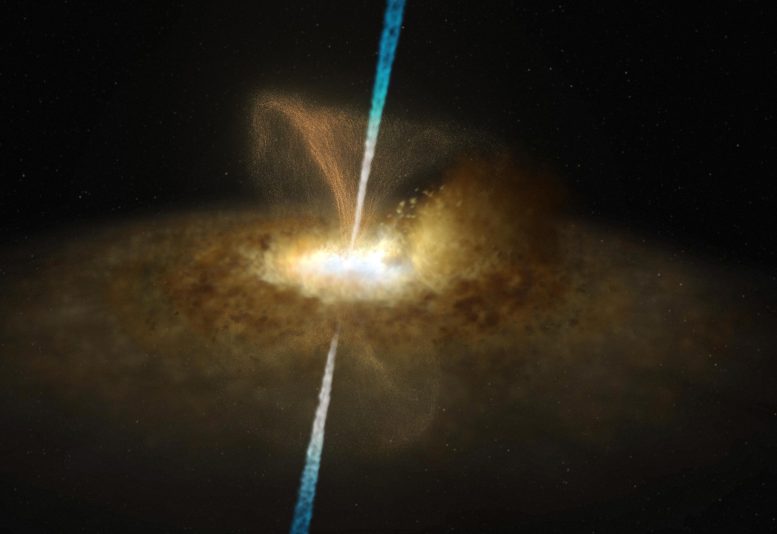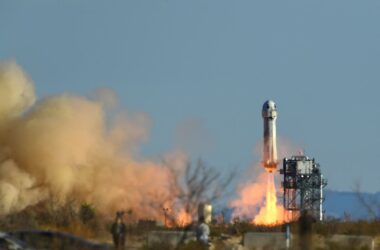
Cette illustration montre à quoi pourrait ressembler le noyau de Messier 77. Comme d’autres noyaux actifs de galaxie, la région centrale de Messier 77 est alimentée par un trou noir qui est entouré d’un mince disque d’accrétion, lui-même entouré d’un épais anneau ou tore de gaz et de poussière. Dans le cas de Messier 77, cet anneau épais masque complètement notre vue du trou noir supermassif.
On pense également que ce noyau galactique actif possède des jets, ainsi que des vents de poussière, qui sortent de la région autour du trou noir perpendiculairement au disque d’accrétion qui l’entoure.
Crédit :
ESO/M. Kornmesser et L. Calçada
Une équipe internationale d’astronomes dirigée par Violeta Gámez Rosas (Université de Leiden) a observé une étoile supermassive. trou noir caché dans un anneau de poussière. Cette découverte confirme l’idée que les centres actifs des galaxies sont beaucoup plus semblables que ne le montrent les observations, car l’angle de vue depuis la Terre provoque des distorsions. Les recherches ont été effectuées à l’aide de l’instrument MATISSE, co-développé aux Pays-Bas, qui combine la lumière infrarouge de quatre très grands télescopes européens (VLT) au Chili.
Les noyaux actifs de galaxie (AGN) sont des sources extrêmement énergétiques alimentées par des trous noirs supermassifs. Cette courte vidéo donne un aperçu de ces objets particuliers en présentant une nouvelle découverte sur le NGA au centre de la galaxie Messier 77. Crédit : ESO
MATISSE is the acronym for Multi AperTure mid-Infrared SpectroScopic Experiment. MATISSE not only couples the light from the VLT, but also analyzes it. MATISSE was created specifically for infrared light with wavelengths between 3 micrometers and 13 micrometers. Infrared light is also created when something gives off heat. Therefore, MATISSE is cooled to minus 241 degrees Celsius so the instrument itself does not interfere with the measurements.

The MATISSE instrument when it was built at NOVA and had not yet been installed in Chile at the VLT. Credit: NOVA
Nanometer precision
Netherlands Research School for Astronomy (NOVA) built all the lenses and mirrors in the cooled part of MATISSE together with the Dutch space industry. The Netherlands had gained experience while developing its forerunner MIDI, which could link two telescopes instead of four.
The heart where the beams of the four VLT telescopes converge, consists of two aluminum boxes that are almost a meter in size. These boxes are filled to the brim with hundreds of optical components, dozens of sensors and dozens of tiny motors. Most of the components work with nanometer precision or even higher.

The left panel of this image shows a dazzling view of the active galaxy Messier 77 captured with the FOcal Reducer and low dispersion Spectrograph 2 (FORS2) instrument on ESO’s Very Large Telescope. The right panel shows a blow-up view of the very inner region of this galaxy, its active galactic nucleus, as seen with the MATISSE instrument on ESO’s Very Large Telescope Interferometer. Credit: ESO/Jaffe, Gámez-Rosas et al.
For more on this discovery, see Supermassive Black Hole Caught Hiding in an Immense Ring of Cosmic Dust.
Reference: “Thermal imaging of dust hiding the black hole in the Active Galaxy NGC 1068”by Violeta Gámez Rosas, Jacob W. Isbell, Walter Jaffe, Romain G. Petrov, James H. Leftley, Karl-Heinz Hofmann, Florentin Millour, Leonard Burtscher, Klaus Meisenheimer, Anthony Meilland, Laurens B. F. M. Waters, Bruno Lopez, Stéphane Lagarde, Gerd Weigelt, Philippe Berio, Fatme Allouche, Sylvie Robbe-Dubois, Pierre Cruzalèbes, Felix Bettonvil, Thomas Henning, Jean-Charles Augereau, Pierre Antonelli, Udo Beckmann, Roy van Boekel, Philippe Bendjoya, William C. Danchi, Carsten Dominik, Julien Drevon, Jack F. Gallimore, Uwe Graser, Matthias Heininger, Vincent Hocdé, Michiel Hogerheijde, Josef Hron, Caterina M. V. Impellizzeri, Lucia Klarmann, Elena Kokoulina, Lucas Labadie, Michael Lehmitz, Alexis Matter, Claudia Paladini, Eric Pantin, Jörg-Uwe Pott, Dieter Schertl, Anthony Soulain, Philippe Stee, Konrad Tristram, Jozsef Varga, Julien Woillez, Sebastian Wolf, Gideon Yoffe and Gerard Zins, 16 February 2022, Nature.
DOI: 10.1038/s41586-021-04311-7



